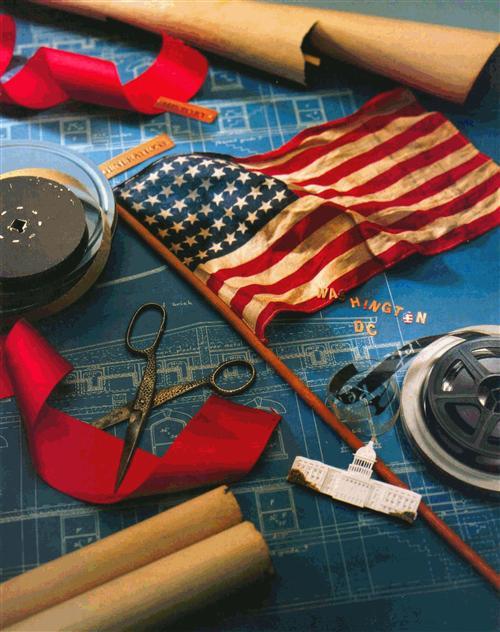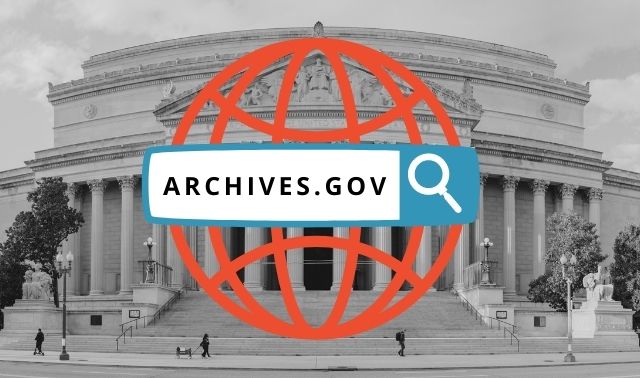 The National Archives and Records Administration (NARA) could be called the “Nation’s Attic.” not only does it house the constitution and the declaration of independence but it also holds millions of federal records with clues to your family’s past. Here you’ll find us censuses, military pensions and service records, passenger arrival records, homestead records, court of claims files, bounty-land warrants, bureau of Indian Affairs Records, Freedmen’s Bureau Records, border-crossing records and much more.
The National Archives and Records Administration (NARA) could be called the “Nation’s Attic.” not only does it house the constitution and the declaration of independence but it also holds millions of federal records with clues to your family’s past. Here you’ll find us censuses, military pensions and service records, passenger arrival records, homestead records, court of claims files, bounty-land warrants, bureau of Indian Affairs Records, Freedmen’s Bureau Records, border-crossing records and much more.I found my great-great-grandfather William Slaker’s Civil War pension record while researching at NARA. This one document told me both the German town where he married my great-great-grandmother Augusta Marie Fischer and the reason for his discharge from the Army. It turns out he was a butcher, a steer fell on him and he was severely injured. So much for a war wound!
You can uncover similar stories about your ancestors by taking a trip to our nation’s capital. And lucky for us, researching at NARA has gotten a whole lot easier. Over the past several years, NARA’s Archives I building (NARA also has several regional facilities) has undergone extensive renovation. To much media fanfare last September, NARA reopened the Rotunda, the archives’ biggest tourist attraction and the home of the newly encased Charters of Freedom. But for family historians, the most exciting development at NARA is the new Research Center, which opened last October.
In the past, researching at the National Archives required navigating between multiple floors and through a labyrinth of rooms. To newbies, the archives may have actually felt like an attic because you had to maneuver through nooks and crannies to find what you needed.
Now, just about everything you need is in the Research Center on the ground floor. This new location cuts down on the long wait for elevators, and makes your overall research efforts much more efficient. It’s designed to be a one-stop experience, but there are actually many stops within the Research Center. The National Archives is one of my favorite places to research, and I’m here several times each year. On my last visit, in November 2003, I learned the ins and outs of this new family history hub. Make your next (or first) trip to the archives a success with this room-by-room guide.
Getting acquainted
Upon entering the Archives I building on the Pennsylvania Avenue side, you’ll need to show a photo ID at the security check. You’ll also put your hags, computer and notebooks through the security system — much as you would at an airport. The Research Center entrance is just beyond the guard desk and between the building’s main elevators. If you’ve been to the National Archives before, you’ll notice that the Research Center has the same feel as the rest of the nearly 70-year-old building. But it’s definitely a step up from the maze of rooms on the fourth floor, where the research materials used to be. All of those resources arc now located on the ground floor. You still need to go to the second-floor Central Research Room (Room 203) to view original records, though.
You’ll enter a large lobby area with rich wood paneling and comfortable seating. From there, you can access all Research Center amenities and services. If you have questions about where to find certain resources, NARA staff can point the way.
To the right of the Research Center entrance, you’ll find the cashier’s office. Here, you can purchase debit cards for making self-service copies. Although you can get these cards from dispensers in the Research Center and Central Research Room, you can put your purchases on a credit card at the cashier’s office.
Just outside the office is a rack of NARA publications, including Guide to Genealogical Research in the National Archives, Guide to Federal Records in the National Archives of the United States and Guide to Records in the National Archives Relating to American Indians. You can pay for these books at the cashier’s office. (The office is open 9 a.m. to 4:30 p.m. Monday through Friday.) To learn about these publications before your trip to the archives, visit NARA’s Web site <www.archives.gov> and select Publications from the pull-down menu.
Genealogy Consultation Room
From the lobby, go to the Genealogy Consultation Room, straight ahead of the Research Center entrance. Here, you’ll find assistance from NARA staff and volunteers, and you can register to use microfilm. Color-coded fliers will save you some research time by quickly directing you to specific records. If you’re interested in military records, for example, look for the green papers (and remember that there are separate fliers for different eras and wars). If you plan to order original records, you’ll need to obtain a researcher identification card here, too.
Soon, staff will add computers to the Genealogy Consultation Room, so you can access NARA’s Archival Research Catalog (ARC) and other online resources. ARC describes NARA’s vast holdings and includes some digital images of the archives’ treasures. From these computers, you’ll also have unlimited access to NARA’s AncestryPlus <www.gale.ancestry.com> and Heritage-Quest Online <www.heritagequest.com> data subscriptions.
The Textual Records Finding Aids Room and Archives Library Information Center already have computer terminals for public use. Most of the databases on the NARA Web site are accessible via your home computer, too. That means you can scope out NARA’s holdings before even setting foot in Washington. To access ARC, for example, select Archival Research Catalog from the pull-down menu on the NARA home page.
Microfilm cabinets
One of NARA’s greatest assets is its massive microfilm collection. And after searching the online microfilm catalog (from the NARA home page, select Archives Library Information Center, then Microfilm Catalog), you’ll be itching to check it out.
The microfilms are self-service: You retrieve them (one at a time) from the cabinets and replace them when you’re done. NARA staff can help you get started, though. You’ll find the cabinets in two long rooms just before the Microfilm Research Room entrance. The films are filed by NARA number (such as T288, General Index to Pension Files 1861-1934), which you’ll find in the catalog and other finding aids. You can scan the rows of cabinets for the microfilm you need, but to save time, I recommend looking up the microfilm number in the Location Register. The register will tell you which drawer holds the film.
Microfilm Research Room
Once you’ve found the microfilm you need, head over to the Microfilm Research Room. The room is equipped with about 80 microfilm readers at individual workstations. Each station’s numbered so you can find your way back after retrieving a roll of microfilm or making a copy.
The new L-shaped stations, which have extensions on either the left or the right side, accommodate individual work preferences. With dividers similar to those found on office cubicles, they also offer privacy. Returning researchers will find that this room’s quieter than the old fourth-floor microfilm room.
If you’ve brought your laptop along, just plug it into the outlet on the workstation divider. You can run a cable lock through the cutout space in the desk. This works well if you have an extra-long cable; however, if your cable is too short, you’ll be crouching down to attach it to the desk bracket underneath the work space.
At the front of the room, you’ll see a row of microfilm copiers, which are operated by copy card. Once you find something to copy, take both reels off the microfilm reader and up to the copiers. If you’re not sure how to work them, ask NARA staff for assistance.
This room also houses maps, a microfilm copier you can reserve for extensive duplicating, reference materials, census abstract forms and other finding aids. Plus, there are boxes for recycling paper.
Textual Records Finding Aids Room
Want to see the original records created by or about your ancestors? Then move over to the Textual Records Finding Aids Room (formerly on the fourth floor) to request land records, federal court records, military records and more. If you read some of the guides and catalogs mentioned here or on the NARA Web site, you’ll be more informed about the types of records available. You’ll also see many finding aids and general reference guides on the shelves in this room. Give yourself plenty of time to scan through them; you might uncover some surprising records that will benefit your research.
The staff can direct you to the materials you need. Some members of NARA’s staff have specific areas of expertise: One might be more familiar with military records related to the Civil War; another might be a War of 1812 whiz. All NARA staff can assist you with general questions and finding aids. For more-specialized help, ask about making an appointment with an expert in your area of interest.
To order original records, present your researcher identification card. Then fill out a Reference Service Slip and turn it in to the staff. A posted sheet tells you what information to include on the slip. Ask for help with the specific location numbers for your items.
The records you order in this room will be delivered within one to two hours to either the Military Service Records Research Room or the Central Research Room. (In some cases, you’ll find that the records you want have been microfilmed, which means you’ll have instant access to them.) Just ask the staff where and when your records will be ready. And remember that if you want to view records on a Saturday, you’ll have to order them during the business week. Records are pulled between 9:30 a.m. and 3:30 p.m. on weekdays only. The Textual Records Finding Aids Room is closed Saturdays and evenings.
Military Service Records Research Room
If you request pre-World War I service records, pension files or bounty-land warrants, you’ll view them in the Military Service Records Research Room, on the opposite side of the lobby from the Textual Records Finding Aids Room.
As you enter the room, the guard on duty will electronically swipe your researcher ID card and make sure you’re not bringing in briefcases, computer bags, notebooks, hats or pens. NARA staff will supply paper and pencils. Outdoor jackets and coats aren’t allowed, either, but you can wear a light jacket, suit coat or sweater. The room’s furnished with individual workstations, computers and two photocopiers. Upon your departure from this room, a guard will check any copies you’ve made.
Archives Library Information Center
Before the renovation, the building had no centralized or easily accessible general library. The new Archival Library Information Center (ALIC) solves that problem. The open shelves in this area are terrific for browsing. In fact, I found so many interesting books in ALIC that I needed to spend extra time here. ALIC holds federal government publications, state histories, histories of American Indian tribes, biographies, published passenger lists, atlases, military histories, general reference books and more. You’ll also have access to computers and a variety of CD-ROMs, including census indexes. ALIC houses an array of genealogical and historical periodicals (current and back issues), as well. You can search ALIC’s Online Public Access Catalog from home at <archives.gov/research_room/alic>.
Lecture rooms
Want to learn how to use passenger, court or military records? NARA offers sessions on a variety of genealogical topics, many of which will be held in the new lecture rooms, to the left of the Genealogy Consultation Room. Some sessions are free; others cost a few dollars. For a schedule of upcoming lectures and other Archives I events, visit the NARA Web site and select Calendar of Events from the pull-down menu. Seating is limited, so try to make reservations.
New additions, old rules
Just as before the renovation, you’ll store all personal items — jackets, briefcases and notebooks if you’re doing textual research — in lockers. But you’ll be happy to know that the brand-new Research Center lockers are much larger than the old ones. NARA also added new restrooms and drinking fountains.
And as with any research repository, there are rules to follow. You may use only one roll of microfilm at a time. Food and beverages (even in closed containers) aren’t allowed in any of the research rooms. Cell phones must be turned off. And children under 14 are not permitted at this NARA location unless they are actively researching (not just tagging along) under adult supervision. (Advance permission must be arranged with NARA.) You’ll find these and other rules posted in the research rooms and online.
Be prepared
Before your visit, check the NARA Web site to brush up on guidelines and finding aids. You can even do some of your preliminary research from home by searching the online catalogs (see box at right). Remember that some NARA publications, including inventories and guidebooks, are online, too. You can order others for a small fee.
Be sure to wear comfortable shoes. Even though most of the resources are on one floor, you’ll still be doing quite a bit of walking. The Research Center is handicapped-accessible; however, patrons may need assistance with the upper microfilm cabinets.
The Research Center was designed with the needs of researchers like you in mind. Whether you’ve been to the National Archives before or this is your first trip, I’m sure you’ll appreciate the new area. If you don’t know where to find something, just ask the staff. And if they’re busy, other researchers might be able to show you how to find a record or make a copy. After reading this article, you’re already off to a great start.
National Archives and Records Administration
700 Pennsylvania Ave. NW Washington, DC 20408 (866) 325-7208 <www.archives.gov>




